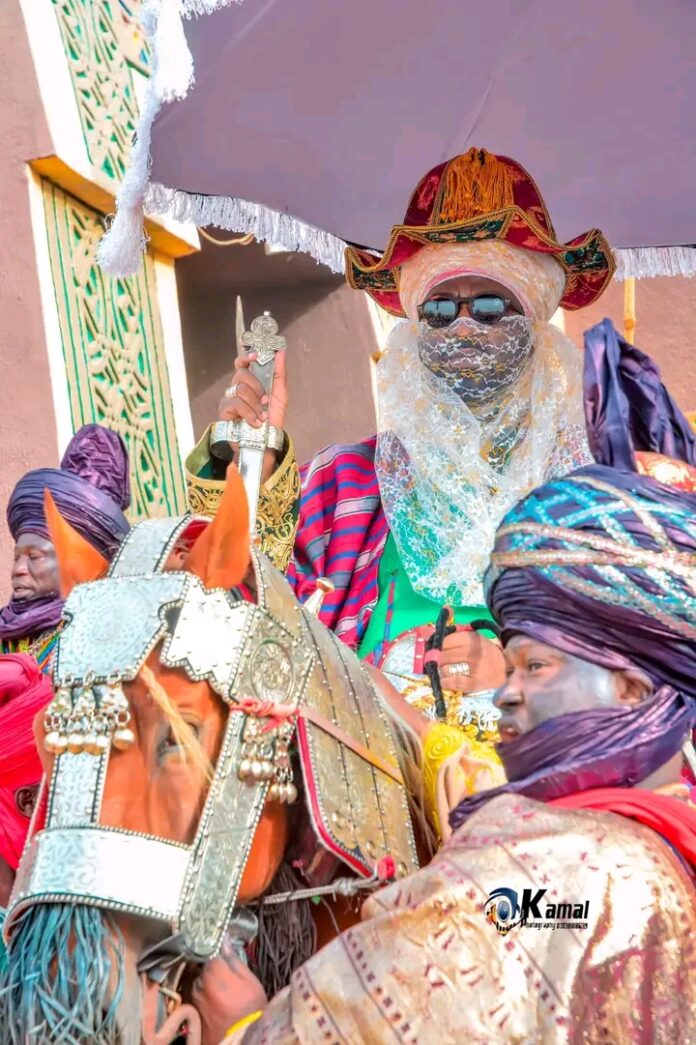
By Abdussamad Ahmad Yusuf
With Hawan Fanisau, Sarkin Kano has completed the Sallah durbar ritual this Eid el-Fitr. Ideally, it would have been Hawan Ɗorayi, where the emir mount horse from the Kano city seat of power, Gidan Rumfa, to Gidan Sarki Dorayi — a mini palace on the outskirts of Kano located at Dorayi town.
Out of magnanimity and contribution to the drive for food security, the Kano emirate changed Dorayi for Fanisau since Eid el-Fitr now are during the dry season.
“We must look at our culture and see how we can maintain it, no matter how things are changing,” says Alhaji Aminu Ado Bayero, CFR, the 15th Fulani Emir of Kano, in an interview with Al-Jazeera English while they were filming a documentary on the epic Kano Eid el-Fitr durbar, 2024, a few days ago.
Kano durbar evolve from traditional and historical events and not out of vacuum. Except Hawan Nassarawa, which symbolizlses a nexus between Kano and imperialism, all others date back to at least some 500 years ago.
A certain Shamakin Kano, a senior slave of Sultan Muhammadu Rumfa (1463-1499), missed the eid pageantry due to illness. The Shamaki a day later, resumed duty and lamented to the Rumfa he missed the Hawan Idi. Out of respect for his trusted servant Rumfa promised to organise a pageantry specifically for him. Immediately after asr prayer, Rumfa ordered a procession from the Kano city palace to Gwangwazo, where the king’s mother resided. That’s how Hawan Daushe evolved, and the Shamaki is the Shamakin Kano Daushe.
Emir Aminu Ado Bayero had held several titles, including Ɗanmajen Kano, Ɗanburan Kano, Turakin Kano, Sarkin Dawakin Tsakar gida, and Wamban Kano. As the Sarkin Dawakin Tsakargida and later Wambai, a senior councilor, he chaired Kano emirate durbar committee for close to a decade supretending the organisation, preparation, and execution of pageantry for late emir Alhaji Ado Bayero, the most magnificent Fulani emir of Kano, and the flamboyant Malam Muhammadu Sanusi II, his succesor!
These credentials placed Aminu Bayero on a higher pedestal to understand the culture, sub-cultures, and traditions of the Kano emirate; how to better strategise; sustain; and promote them. It’s no surprise that this has, for the first time, invited the attention of Al-Jazeera, global media powerhouse, to tell the story of Kano Sallah durbar. The first in history!
This return to tradition has brought fresh breeze to the role of Kano in African arts and culture around the personality of the emir.
From Hawan Idi, Daushe, Nasarawa to Fanisau, Aminu Bayero has demonstrated the age-old tradition and its adaptation to changes in modern Kano — from his dressing in traditional royal regalia and paraphernalia to the majestic steps out of Gidan Rumfa; and the astonished admirers chanting “Allah ƙara lafiya” and various prayers revering their emir.
Yahaya, a childhood friend we remained committed together attending the Kano eid ground at Kofar Mata since the days of late Ado Bayero. He was amused this year to see Aminu Ado in such royal splendor. This true allegiance to Kano tradition without borrowing from either the east or west. “Indeed, with Aminu comes the revival of Kano Hawan Sallah,” Yahaya whispered to me, raising his smartphone to record a video of the procession.
As I argued last year: “From Muhammadu Rumfa, who instituted the Hawan Sallah, to Ado Bayero, who gave it its electrifying image, to the majestic Muhammadu Sanusi II, who time-traveled us to the times of the enigmatic Muhammadu Sanusi I, Aminu Ado-Bayero is a summation of all the Kings and Emirs that have given Kano Sallah its “completeness” and perfection.
Mr Yusuf wrote in from Kano via Abdussamadahmad69@gmail.com





































